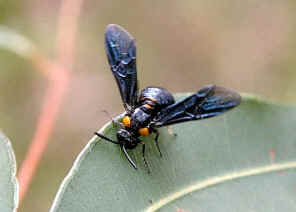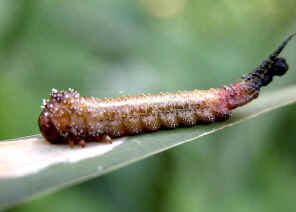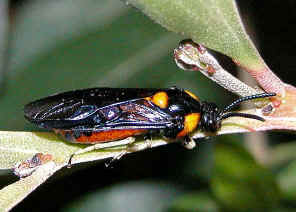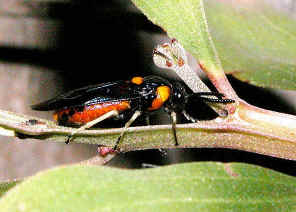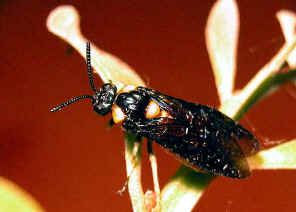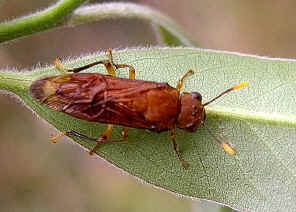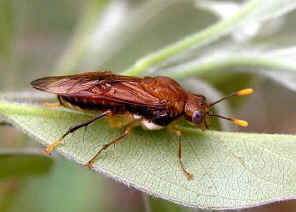|
|
Sawflies - Suborder Symphyta
The common name 'Sawflies' is misleading. They are not flies. Sawflies are closely related to wasps. They got their common name because the female have their special egg-laying tool, like a saw, to cut through leaf tissue for their eggs. Their adults look similar to wasps except they do not have the 'waist'. Sawflies do not sting. They do not form the social organization like wasps, bees or ants, but their larvae do stay together for the defence.

- Sawfly, body length 25mm
Sawfly larvae are sometimes seen on trees and shrubs, more commonly seen
than their adults. Sawfly larvae are vegetarians and feed on
leaf. Unlike other members in the order Hymenoptera, Sawfly parents do not provide parental care to their young, except
they lay them on the suitable food plants and some species guard their eggs until they hatch. It is believe that the ancestor of hymenopterans, i.e., ants, wasps, and
bees, look
like the Sawflies. The larvae of Sawflies are look similar to the moths
or butterflies caterpillars but they have six or more pair of prolegs while
caterpillars usually have five pairs or less.
Adult sawflies do not sting. However, the larvae may secrete irritating liquid onto the skin or eyes if disturbed.
Sawflies are in the same order Hymenoptera as ants, bees and wasps. Ants, bees and wasps are placed in suborder Apocrita. Sawflies are placed in a suborder Symphyta. They are different families in the Sawfly suborder. Up to now all sawflies we found are in family Pergidae, which is the most common Australian sawfly family.
- Bramble Sawfly, Red Ash Sawfly
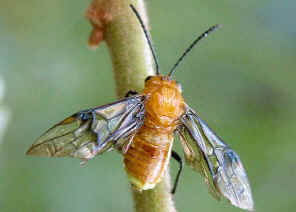
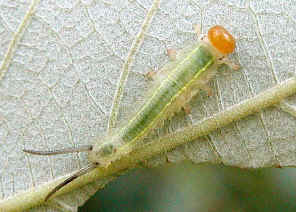
- Philomastix xanthophilus, Family PERGIDAE, Subfamily Philomastiginae,
- Adult body length 12mm, larva 20mm
- We found this group of sawfly larvae in early winter. They are pale green in colour. Their head is pale orange in colour. There are two tails at the end of their abdomen. On the stem of the same plant, we found two adult sawflies. We believed they are the larvae's parents, although we was not sure if they are one male one female or both females. The adults were pale brown in colour with long antenna. More information and pictures please click here.
- Melaleuca Sawfly, Paperbark Sawfly
- Lophyrotoma zonalis, FAMILY PERGIDAE, subfamily Pterygophorinae, adult body length 20mm, larva length 25mm
- This sawfly is dark blue in colour with orange spots on thorax and orange rings on abdomen. Its wings are dark blue as well. We found this sawfly active flying among young gum trees in Alexandra Hill in mid summer. The larva was found during mid summer in Alexandra Hill. We tried to raise them as raising the moth caterpillars a few times, but never success.
- Reference:
- 1. Wildlife of Tropical North Queensland - Queensland Museum Publications 2000, p127.
- Brown Sawfly
- Perga sp. family PERGIDAE, subfamily Perginae, body length 25mm
- We found this adult in Alexandra Hill during mid summer. It was resting on a small tree and ignoring our disturbance.
- Sawfly Larvae
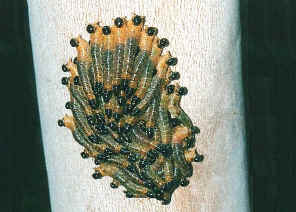

- Perga sp. family PERGIDAE, subfamily Perginae, length 25mm
- Sawfly larvae are vegetarians and feed on leaf. During the evening they grouped together to rest, they help to avoid the predators. When disturbed (the second picture), they waved their tails together and usually will scare away the predator.
- Gum Tree Sawfly Larvae
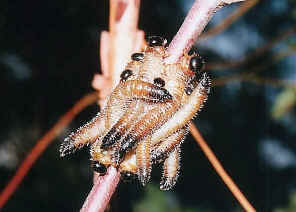
- Perga sp., family PERGIDAE, subfamily Perginae, length 25mm.
- Sawfly larvae in group, each 20mm. When disturbed, all caterpillars bend their bodies, i.e. pointing their tails outwards at the same time, will scare away most of the predators. They feed on the gum tree leaves, disperse at night and gather together during the day.
- Sawfly Larva
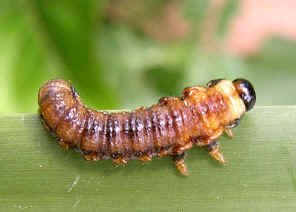
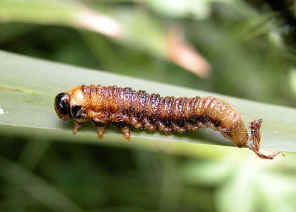
- Perga sp. , family PERGIDAE, subfamily Perginae, length 25mm.
- The larvae of Sawflies are look similar to the moths or butterflies caterpillars but they have six or more pair of prolegs while caterpillars usually have five pairs.
- Leaf Blister Sawfly Larvae


- Phylacteophaga eucalypti, family PERGIDAE, subfamily Phylacteophaginae, length 30mm
- Sawfly Larvae feeding on gum tree leaf. The brown one found on the ground near the gum tree. Both are 30mm in length. When disturbed, they life up their black needle like tails.
- Sawfly Larvae on Gum leaf


- Phylacteophaga sp., family PERGIDAE, subfamily Phylacteophaginae, length 10mm to 30mm
- On a young gum tree, we found quite a lot of this sawfly larvae feeding on the leaves. They are group together when feeding. The larger larvae mixed with the small one, feed on leaf starting at the same edge until finished. When disturbed (2nd picture), they all raised their tails.
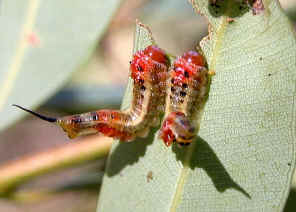
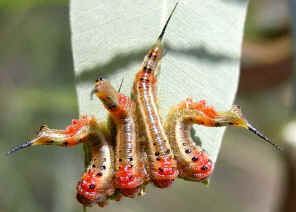
- From the above two pictures, we guess they raised their tails to mimic the hawk claws, which most of their predators will deadly afraid of.
- Sawfly Larvae and Tachinid Fly
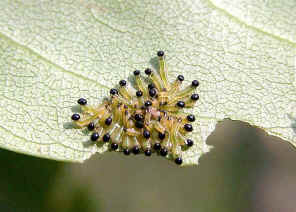
- ? sp., larvae length 5mm
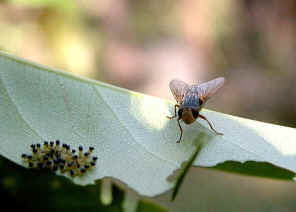
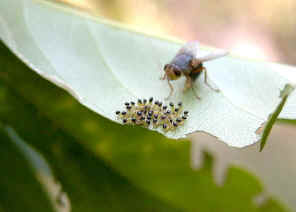
- The above pictures show a Tachinid Fly checking the sawfly larvae and about to lay eggs on the larvae. The white eggs of the fly will attach on the body of the larva. The egg hatches into maggot and bores into the body, develops inside and kill the larva.
